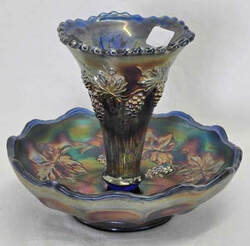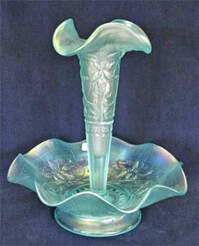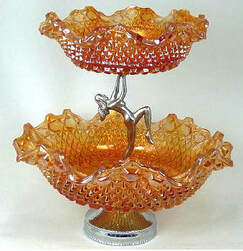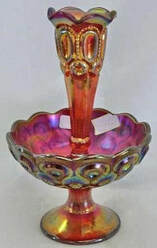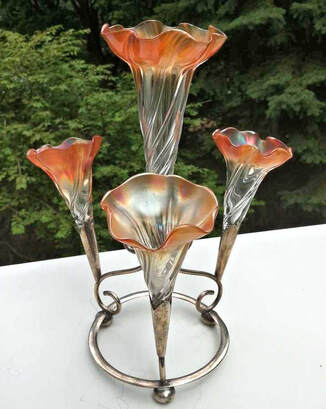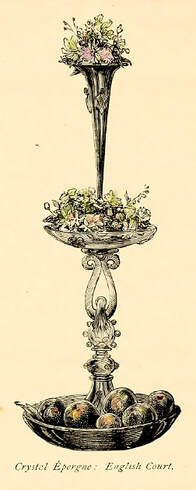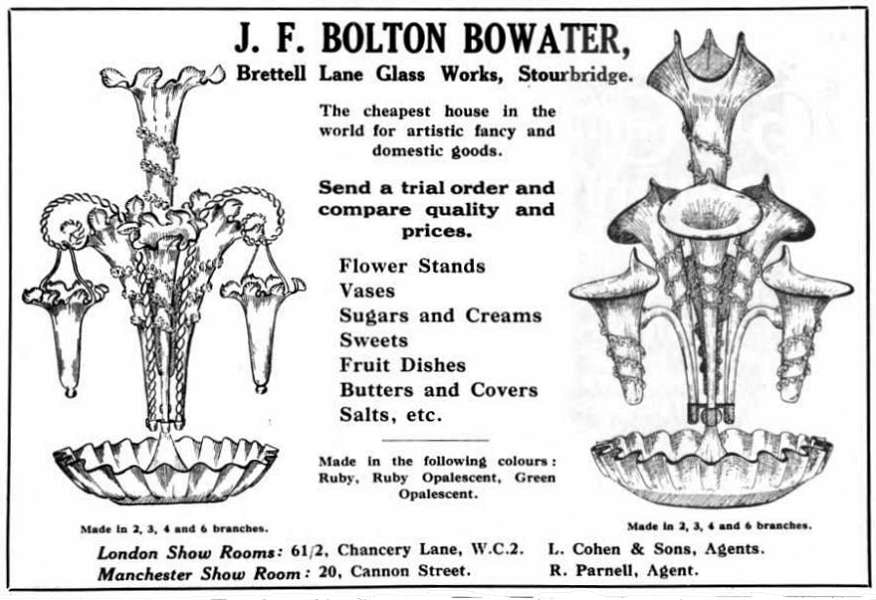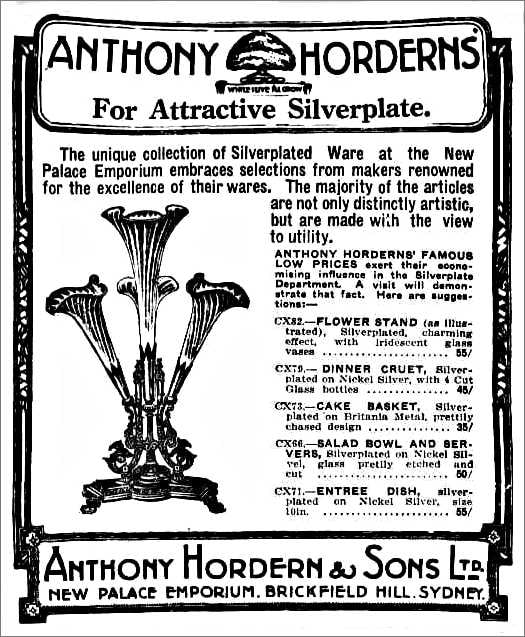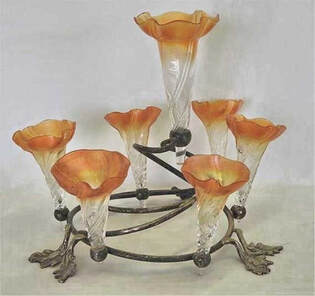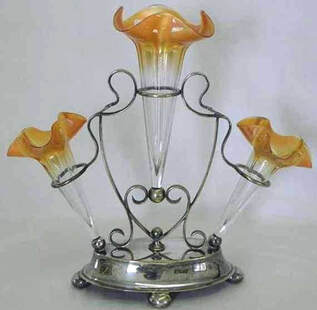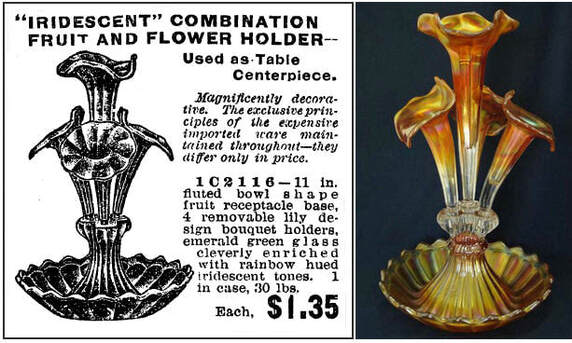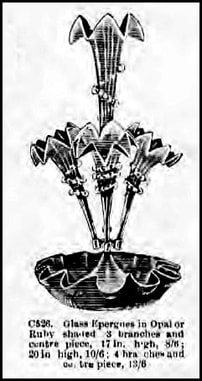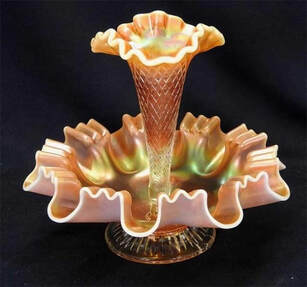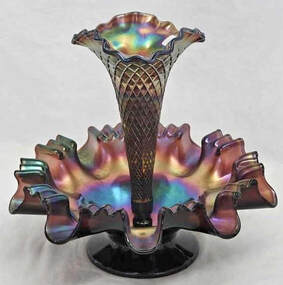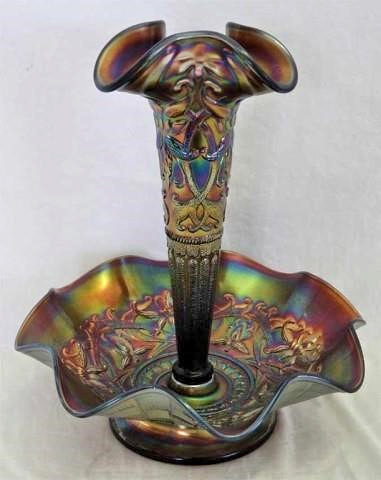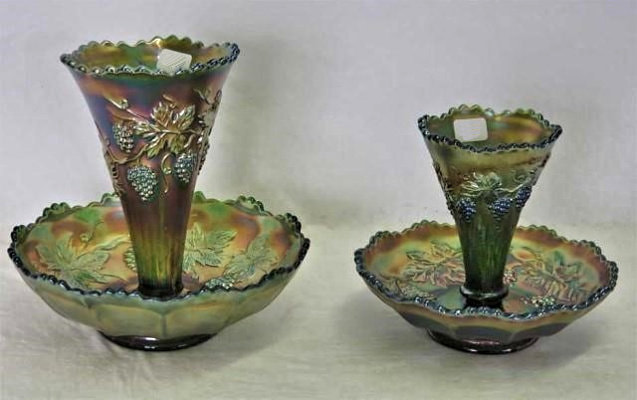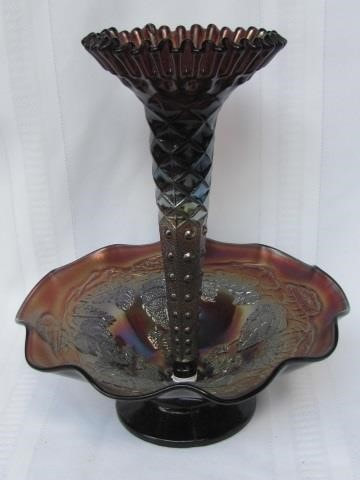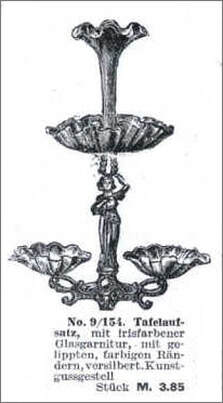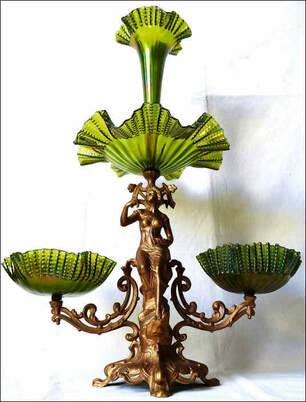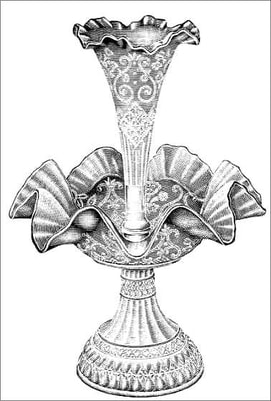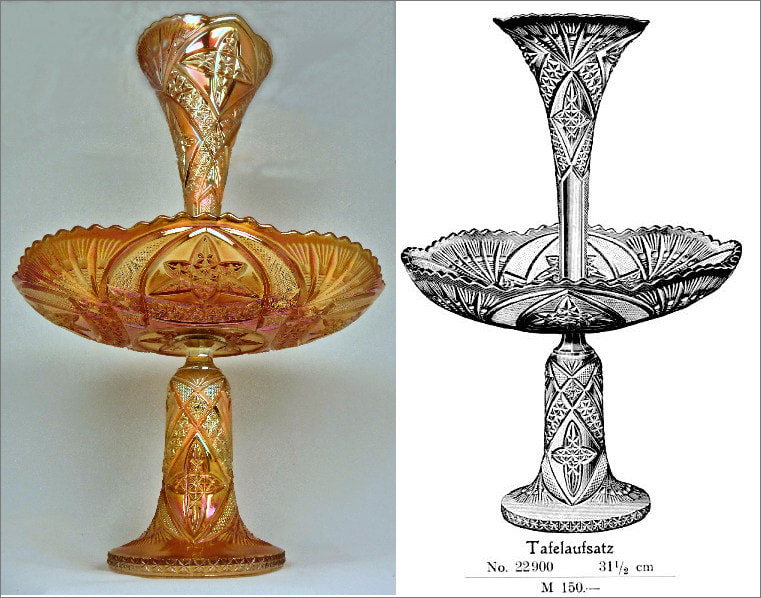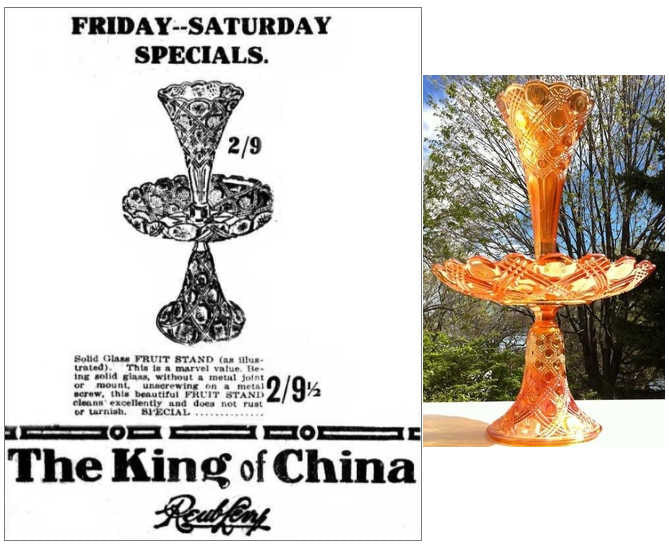Epergnes
The enduring appeal of Carnival epergnes - from Classic through to Contemporary!
Left to right: Vintage in blue (small size), Fenton; Wishbone in ice blue, Northwood; Chunky in marigold, Sowerby;
Moon and Stars, Contemporary red, signed Robert Hansen. Pictures (except Chunky) courtesy of Seeck Auctions.
Sowerby’s Chunky (#2266, aka English Hobnail, aka English Hob and Button) was made in both two and three-tier sizes,
and utilises metal ware to give an Art Deco feel.
Left to right: Vintage in blue (small size), Fenton; Wishbone in ice blue, Northwood; Chunky in marigold, Sowerby;
Moon and Stars, Contemporary red, signed Robert Hansen. Pictures (except Chunky) courtesy of Seeck Auctions.
Sowerby’s Chunky (#2266, aka English Hobnail, aka English Hob and Button) was made in both two and three-tier sizes,
and utilises metal ware to give an Art Deco feel.
The epergne – a fancy, ornamental centrepiece – was typically used for holding fruits and (or) flowers. Other names used include table centrepiece, flower centre, flower or fruit stand or flower holder – and they were made of glass, metal or a combination of both. The epitome of good taste, epergnes were the must-have item of the mid to late 1800s to the early 1900s, for wedding gifts, prizes, leaving presentations and so on, and surely made an impressive statement in the centre of a table or dresser (sideboard), sometimes reaching a height of two feet or more!
|
In its simplest form the epergne consisted of a shallow dish with a trumpet-shaped vase rising from a socket in the centre. In more elaborate style, the central section was elevated, and the central vase was surrounded by smaller ones (the vases in the epergne are often referred to as lilies or trumpets). The ones concerning us, of course, were made of glass – iridescent glass – sometimes paired with metal-ware. They gained popularity in the Victorian era, and the first newspaper ad we have found featuring an iridescent example, was this one (below, centre) from 1904, which was in the Sussex Express (England). The early glass epergnes were made by a number of glassmakers including Bolton Bowater and Burtles & Tate in England, while Stevens & Williams and Thomas Webb also made epergnes in iridescent glass, often with marigold treatment around the top part of the epergne lilies. These would have been blown glass items, not press-moulded. |
Above: International Exhibition, 1876, Philadelphia. Glass epergne made in England. Hand tinted image.
|
|
The Stourbridge glass maker, Bolton Bowater (est. 1896), specialised in Flower Stands (epergnes). Take note of the lower (bowl-shaped) part of the Bolton Bowater epergnes – we’ll be seeing that shape again in other epergnes from both Northwood and Contemporary Fenton.
Above: British Pottery Gazette ad for the Stourbridge glass maker, Bolton Bowater
Above: for tighter budgets, smaller epergnes were also made using cheaper,
silver-plated metal stands using EPNS (electro-plated nickel silver). The fascinating ad shown above is from a 1910 Boots the Chemist catalogue (England), showing a wide variety of glass vases/lilies on electro-plated stands. It’s highly likely many of the glass lilies would have been iridised too. |
Above: a 1918 ad from the Sydney department store, Anthony Horderns. Note that the epergne illustrated is called a “Flower Stand” and has “iridescent glass vases”.
Above and below: part-iridised epergne lilies mounted in metalware, courtesy Seeck Auctions. Probably Stevens & Williams,
|
Moulded Glass Epergnes
Although many of the early glass epergne lilies were made from blown glass, pressed glass epergnes soon began to be popular too – indeed, both pressed and blown epergnes were made in iridised form, contemporaneously, in the early 1900s.
Northwood’s splendid Wide Panel epergne was featured in Butler Brothers’ catalogues from 1909 - see below. It was described as an “Iridescent Combination Fruit and Flowers Holder" to be "Used as a Table Centerpiece”. The pressed glass versions had the advantage of cheaper cost, a fact that is borne out by the ad, in which the text states that “the exclusive principles of the expensive imported ware maintained throughout – they differ only in price”. Carnival Glass makers were creating more affordable versions of the blown “Art Glass” epergnes, noticeably those from Bolton Bowater (clearly shown by the similarity of the form of the base bowl of Northwood’s Wide Panel epergne to the Bolton Bowater version that we looked at earlier).
Although many of the early glass epergne lilies were made from blown glass, pressed glass epergnes soon began to be popular too – indeed, both pressed and blown epergnes were made in iridised form, contemporaneously, in the early 1900s.
Northwood’s splendid Wide Panel epergne was featured in Butler Brothers’ catalogues from 1909 - see below. It was described as an “Iridescent Combination Fruit and Flowers Holder" to be "Used as a Table Centerpiece”. The pressed glass versions had the advantage of cheaper cost, a fact that is borne out by the ad, in which the text states that “the exclusive principles of the expensive imported ware maintained throughout – they differ only in price”. Carnival Glass makers were creating more affordable versions of the blown “Art Glass” epergnes, noticeably those from Bolton Bowater (clearly shown by the similarity of the form of the base bowl of Northwood’s Wide Panel epergne to the Bolton Bowater version that we looked at earlier).
On the right is an extract from a 1910 Foy’s Department store (Sydney) catalogue. The epergne shown is clearly the same as the Bolton Bowater version that we showed earlier, and (given Harry Northwood's long-standing connection to the Stourbridge glass industry in England), it was evidently the "inspiration" for his Wide Panel epergne. (*Image of the marigold epergne is courtesy Seeck Auctions.)
A 1910 Butler Brothers ad for Dugan-Diamond’s Fishnet epergne, a Fishnet epergne in peach opal, and one in purple (pictures courtesy of Seeck Auctions)
Other Carnival epergnes made by US glassmakers include Wishbone (Northwood), Strawberry (Dugan-Diamond) and Vintage (Fenton, in two sizes).
In Europe, elaborate epergnes were advertised in a 1914 M. Liemann wholesale catalogue, featuring iridised glass coupled with splendid metalwork, and
Brockwitz catalogues also featured many fine pressed glass epergnes – both large and small.
Here is a selection.
Brockwitz catalogues also featured many fine pressed glass epergnes – both large and small.
Here is a selection.
|
Above, left to right: an extract from the 1914 M. Liemann catalogue showing an epergne that is very similar to the well-known Goddess of Athena epergne attributed to Brockwitz of Germany. In the centre, is a magnificent epergne that is very similar in design to the Goddess of Athena, but which has different glass elements (courtesy and copyright Mike Krüger, Art & Antiques in the Bauhaus city of Dessau, Germany), and on the right is a Sungold Floral epergne as shown in a Brockwitz catalogue that dates back to at least 1915 and probably earlier. Note the fine crimping on the epergne lily and the bowl.
|
|
A magnificent Brockwitz Curved Star (OMN Zurich) marigold epergne.
It consists of three pieces - the central section is a 12 inch wide flat bowl with a central hole, through which the horn and base are joined with a moulded glass screw. On its right is a Brockwitz catalogue illustration from 1915. |
A Brockwitz Sunspray epergne on a metal stand that was almost certainly added at the time of manufacture, as a number of these identical items are known. Courtesy the late Michael O’Brien.
|
The ad shown on the left below is from a 1914 Australian newspaper for the glass and china retailer, Reub Levy, the self-styled "King of China". It features a Brockwitz Tartan (OMN Kopenhagen) thee-piece epergne, although they referred to it as a "fruit stand". The ad describes it as “solid glass, without a metal joint or mount, unscrewing on a metal screw”. This innovative design was used on a number of Brockwitz epergnes, including the Carved Star shown earlier and also Moonprint examples.
The ad shown on the left below is from a 1914 Australian newspaper for the glass and china retailer, Reub Levy, the self-styled "King of China". It features a Brockwitz Tartan (OMN Kopenhagen) thee-piece epergne, although they referred to it as a "fruit stand". The ad describes it as “solid glass, without a metal joint or mount, unscrewing on a metal screw”. This innovative design was used on a number of Brockwitz epergnes, including the Carved Star shown earlier and also Moonprint examples.
|
Multi-use of various shapes was intended to create epergnes
and centrepiece stands by some enterprising European makers. For example, Rindskopf’s fabulous Winged Deco vase (above) was designed to stand atop an inverted sugar and bowl, to make an entirely new shape, as the catalogue illustration shows. Often the bases of bowls would have recesses specially designed to take the foot of an upturned sugar. |
Brockwitz began making Carnival Glass much earlier than it had previously been thought: the received wisdom was that it was not until the mid 1920s, but . However, we have documented that Brockwitz was almost certainly the first maker of Carnival Glass in mainland Europe in around 1915, and in fact we also found evidence leading us to believe that they were possibly making some Carnival Glass items as early as c.1905.
Read about Brockwitz's Carnival Glass production in our major feature: A Celebration of Brockwitz
Reub Levy - "Elected the King of China" - played a vital role in the importing of Carnival Glass from around the world into Australia. Whilst much of it was from Imperial in the USA, glass from Europe also featured in "The Yellow Store with the Big Dragon on top"! We explored Reub Levy's impact on the availability of Classic Carnival Glass in Australia, and some of his very clever advertising, in a two page feature here: "The King of China".
Contemporary epergnes
Fenton’s Classic Carnival epergnes were limited to the little two-piece Vintage epergnes (made in both 6” and 4¾” heights shown earlier in this article). But they made up for this with their Contemporary output, which included some show-stopping beauties. Here are just three!
Fenton’s Classic Carnival epergnes were limited to the little two-piece Vintage epergnes (made in both 6” and 4¾” heights shown earlier in this article). But they made up for this with their Contemporary output, which included some show-stopping beauties. Here are just three!
|
Shown below is a Fenton Four Lily epergne in willow green opal, courtesy of Seeck Auctions. Its significance is that it featured in "The Fenton Centennial Collection 1905 - 2005", signed by Frank M Fenton. The Fenton 2000 June Supplement pictured on the right featured this epergne, with the following description:
“Particularly fond of epergnes, Frank has selected a Victorian style epergne in historic Willow Green Opalescent (note, also iridescent), with antique glass and brass fittings, as his signature piece for this new collection. A petticoat crimp was used on each threaded horn – all supported by a crimped lily-pad base. Our company first made this epergne in the 1940s for the L. G. Wright Glass Co., as a replica of the Victorian-style “flower stands” popularised by English and American glass companies from 1880 – 1910.” |
Extract from Fenton 2000 June Supplement, courtesy Fenton Art Glass Company
|
And so we go full circle, back to the beginning, with the modern rendition by Fenton of the early Victorian epergnes which is where we started this article.
Shown below on the left is an ad from "The Pottery Gazette" of 1899, in which the renowned English glassmaker, Thomas Webb of Stourbridge, proudly offered "Table Decorations combined with Artistic Metal Work" - namely epergnes.
On the right is an ad from 1911. It was for a retailer in Australia, Shaw & Sons (Brisbane). Given the close similarity to the "Fruit Stand" / epergne shown earlier in the 1910 ad for Bolton Bowater, a glassmaker in Stourbridge, England, this is surely one of their products.
More about Carnival Glass Shapes: Carnival Glass was practical and functional, and it was meant to be used. Bowls of every size, plates, jardinières, jelly comports, custard cups, cake stands, epergnes and even massive table centrepieces. There were punch sets, vases in every shape and size you can possibly imagine, lamps, ashtrays, candlesticks and more …
Here is our homepage for much more information on Carnival Glass Shapes: "What shape was it made in?"
Here is our homepage for much more information on Carnival Glass Shapes: "What shape was it made in?"
